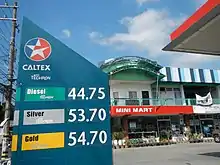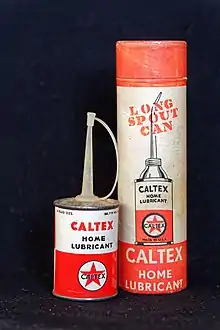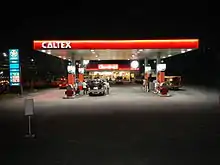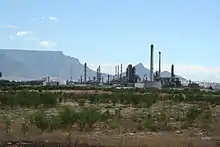Caltex
Caltex is a petroleum brand name of Chevron Corporation used in 29 countries in the Asia-Pacific region, the Middle East, and Southern Africa.[1]
 | |
| Founded | 1936 |
|---|---|
| Products | Oil, Fuel |
| Parent | Chevron Corporation |
| Website | caltex.com/global |

History

Caltex timeline:[2]
- 1936 Chevron and Texaco form the Caltex Group to operate in Africa, the Middle East, Asia, Australia and New Zealand.
- 1940s Caltex aids allied war effort.
- 1947 Tankers purchased from surplus U.S wartime fleet; Texaco's European subsidiaries purchased.
- 1948 Caltex enters partnership with Japan's Nippon Oil Company
- 1949–66 Caltex builds or has interest in new refineries in 20 countries.
- 1967 European interests transferred to Chevron and Texaco; Caltex refocuses on Africa and Asia.
- 1968 Caltex enters Korean market.
- 1981–83 Acquisitions strengthen position in Hong Kong, Thailand, the Philippines and Australia.
- 1982 Caltex corporate headquarters move to Dallas, Texas.
- 1985 Representative office opened in Beijing, China.
- 1990s Caltex moves into promising markets such as India, Sri Lanka, Vietnam, Cambodia, Indonesia and Lebanon.
- 1996 Caltex introduces new corporate and retail identity.
- 1998 Caltex relocates corporate center to Singapore.
- 1998 Caltex reorganizes along functional business lines.
- 1999 Caltex changes name to Caltex Corporation.
- 2014 Caltex shut down Kurnell (Australia) refinery and converted the site to an import facility.
Operations
1941 to 2020
Texaco products were first sold in Australia in 1900. Texas Company Australasia Limited was incorporated in New South Wales in 1918.[3] The Caltex brand name began to be used for the first time in Australia in 1941.[4]
Caltex operated in Australia for another 54 years as Caltex Oil (Australia) Pty Ltd, during which it opened its Kurnell refinery in 1956. It also took over Golden Fleece in 1981.[5] Caltex Oil (Australia) Pty Ltd merged with its rival Ampol in May 1995 to form Australian Petroleum Pty Ltd. Caltex acquired full ownership of Australian Petroleum in 1997 and the merged company was renamed Caltex Australia Limited in 1997.[3]
Until 2015, Caltex Australia was owned 50% by Chevron, and 50% by Australian shareholders. In 2015, Chevron sold its 50 per cent stake in Caltex Australia (the deal valuing the company at AU$9.24 billion), but allowing Caltex Australia to continue using the Caltex brand. In December 2019, Caltex announced that Chevron had given notice to terminate the licence agreement for the use of the Caltex brand in Australia. Caltex Australia was renamed Ampol Limited during the annual general meeting in May 2020.[6] Under the licence agreement, Caltex Australia will have until December 2022 to complete the rebrand.[7]
Since 2020
In November 2019, Chevron announced it would re-enter the Australian market, having purchased Puma Energy's Australian operations.[8] The acquisition was completed in July 2020.[9] Chevron intends to revive the Caltex brand in Australia by rebranding its Puma sites, however, can only do so after the expiry of the licence to Ampol in 2022. In the meantime, Chevron has a licence agreement to continue to use the Puma brand in Australia.[10]
New Zealand
Caltex has been operating in New Zealand since 1936. On 1 June 2016, Chevron New Zealand, which operated the Caltex brand in New Zealand, was acquired by Z Energy Ltd. Z Energy, a New Zealand owned company, operates the Caltex network in New Zealand using the brand under licence from Chevron International. The Caltex-branded retail network is independently owned and operated, with the operators setting their own retail fuel prices.[11] There are more than 140 Caltex branded service stations and 70 truck stops around New Zealand.[12]
Hong Kong
.jpg.webp)
Malaysia
There are around 420 Caltex stations across Peninsular Malaysia and three 3 terminals in Pulau Indah, Prai and a joint-venture in Pasir Gudang.[13]
Pakistan
In 2015, Total Parco announced that it would acquire and rename Caltex petrol pumps in Pakistan by an investment between US$200 million and US$250 million .[14]
Philippines

Caltex was established in the Philippines in 1917 when Texas Company began marketing its products in the Philippines through a local distributor, Wise and Co.[15] In 1921, Texaco (Philippines) was formally established and opened its office in Binondo, Manila.[15] Eleven years later, its Pandacan oil depot was converted into a key distribution terminal to bring products by barge to nearby provinces.[15]
They only sell two kinds of gasoline namely Caltex Platinum (Replacement of Gold) (95 octane) and Caltex Silver (91 octane) and one kind of diesel named Caltex Diesel. All these products contain Techron.[15]
India
Caltex had a subsidiary in India in the early 1940s through the early 1980s, however as state owned corporation Indian Oil came in to market, strategically Caltex decided to reduce its operation in India. In State of Gujarat there were 2 major dealers of Caltex, T.C. Brothers Company (Saurashtra region) & MS. N. K. Sheth Co. CEO of T.C. Brothers Co, was Mr. Tribhovandas D Parekh (also known as Mr. Pampu-sheth ) & Chairman was Mr. Cuhnilal D Parekh. T. C. Brothers company dealt in Petrolium products, service station for automobiles, paint, tiles, pipes, cements and transportation of oil, kerosene, gasoline/petrol in state of Gujarat. In 2010, Caltex started trading under the name GS Caltex.[16]
Singapore
Caltex arrived in Singapore around the 1950s. There are 25 stations across the island.[17]
South Africa

A quarter of Caltex's service stations are located in South Africa making it one of the country's top five petroleum brands. As a subsidiary of Chevron it also owns a refinery in Milnerton, north of Cape Town which has a production capacity of 100,000 barrels per day and produces a range of petrochemical products which include petrol, diesel, jet fuel, liquefied petroleum gas, fuel oil and paving asphalt. The company also has a lubricants manufacturing plant and laboratory in Durban.[18]
Caltex had been criticized frequently.[19]
South Korea
Taiwan
Some Asian operations are run by Caltex (Asia) Limited, based in Taipei.
References
- "Our Journey". Caltex Singapore. Retrieved 6 March 2020.
- Caltex (17 April 1999). "Caltex timeline". Timeline. Archived from the original on 5 October 2000. Retrieved 7 December 2018.
- "History". Ampol Singapore. Retrieved 6 March 2020.
- "2009 Annual Review". Caltex Australia. Retrieved 6 March 2020.
- Caltex absorbs Golden Fleece Canberra Times 16 March 1981 page 6
- Zuchetti, Adam. "Caltex brand to disappear in Australia". Mybusiness. Retrieved 23 December 2019.
- Caltex Announces Intention to Transition to Ampol Brand Caltex Australia 23 December 2019
- Puma Energy announces sale of Puma Energy Australian fuel business to Chevron 19 December 2019
- "Chevron completes acquisition of Puma Energy (Australia) Holdings Pty Ltd". Chevron Australia. 1 July 2020. Retrieved 25 August 2020.
- "Chevron to revive Caltex brand for Puma network". Australian Financial Review. 2 August 2020. Retrieved 25 August 2020.
- "Z Energy Ltd". About Z. Retrieved 13 September 2017.
- "Caltex in New Zealand". Retrieved 13 September 2017.
- "Caltex in Malaysia". Caltex Malaysia. Retrieved 16 October 2016.
- Tariq Ahmed Saeedi. "Total Parco plans Rs21 billion investment for Caltex acquisition". The News International (newspaper). Retrieved 15 September 2020.
- "Caltex in Philippines". Caltex Official Website. Retrieved 12 November 2012.
- "GS Caltex India". GS Caltex Official Website.
- "Caltex in Singapore". Caltex SG.
- "South Africa Fact Sheet" (PDF). Chevron. March 2011. Archived from the original (PDF) on 24 January 2012. Retrieved 17 January 2012.
- "BUSINESS ETHICS: CONCEPTS AND CASES" by Manuel Velasquez, "Archived copy". Archived from the original on 24 March 2012. Retrieved 29 November 2011.CS1 maint: archived copy as title (link)
